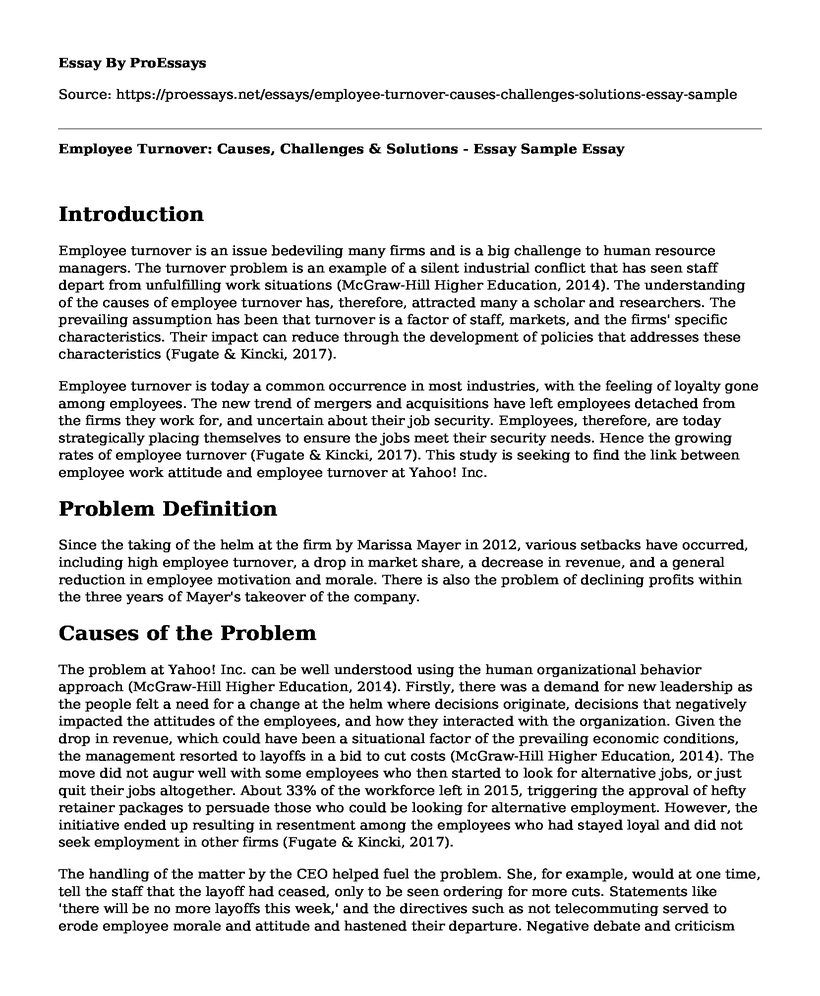Introduction
Employee turnover is an issue bedeviling many firms and is a big challenge to human resource managers. The turnover problem is an example of a silent industrial conflict that has seen staff depart from unfulfilling work situations (McGraw-Hill Higher Education, 2014). The understanding of the causes of employee turnover has, therefore, attracted many a scholar and researchers. The prevailing assumption has been that turnover is a factor of staff, markets, and the firms' specific characteristics. Their impact can reduce through the development of policies that addresses these characteristics (Fugate & Kincki, 2017).
Employee turnover is today a common occurrence in most industries, with the feeling of loyalty gone among employees. The new trend of mergers and acquisitions have left employees detached from the firms they work for, and uncertain about their job security. Employees, therefore, are today strategically placing themselves to ensure the jobs meet their security needs. Hence the growing rates of employee turnover (Fugate & Kincki, 2017). This study is seeking to find the link between employee work attitude and employee turnover at Yahoo! Inc.
Problem Definition
Since the taking of the helm at the firm by Marissa Mayer in 2012, various setbacks have occurred, including high employee turnover, a drop in market share, a decrease in revenue, and a general reduction in employee motivation and morale. There is also the problem of declining profits within the three years of Mayer's takeover of the company.
Causes of the Problem
The problem at Yahoo! Inc. can be well understood using the human organizational behavior approach (McGraw-Hill Higher Education, 2014). Firstly, there was a demand for new leadership as the people felt a need for a change at the helm where decisions originate, decisions that negatively impacted the attitudes of the employees, and how they interacted with the organization. Given the drop in revenue, which could have been a situational factor of the prevailing economic conditions, the management resorted to layoffs in a bid to cut costs (McGraw-Hill Higher Education, 2014). The move did not augur well with some employees who then started to look for alternative jobs, or just quit their jobs altogether. About 33% of the workforce left in 2015, triggering the approval of hefty retainer packages to persuade those who could be looking for alternative employment. However, the initiative ended up resulting in resentment among the employees who had stayed loyal and did not seek employment in other firms (Fugate & Kincki, 2017).
The handling of the matter by the CEO helped fuel the problem. She, for example, would at one time, tell the staff that the layoff had ceased, only to be seen ordering for more cuts. Statements like 'there will be no more layoffs this week,' and the directives such as not telecommuting served to erode employee morale and attitude and hastened their departure. Negative debate and criticism which ensued in the media saw the company not able to recruit qualified personnel. There also arose cases of dissent among the management, especially when supervisors were informed to report inaccurately concerning employees missing work, just to weed out some and hopefully meet the bell curve. Most employees smelled biasness, claiming that its application was not fair across the board (Fugate & Kincki, 2017).
Recommendations
The situation at Yahoo! Inc. may be dealt with by finding solutions to them. First, decision making should involve the inputs of the employees, given that they are the implementers of the same. Layoffs should not be directly linked to a reduction in profits, as the latter may be due to a situation in the economy, and not employee numbers. Hence an objective assessment needs to be carried out (McGraw-Hill Higher Education, 2014).
The firm should also work on an attractive pay package to help them retain the best brains. Communication is also a glaring problem worth addressing in this case. The company should adopt a professional way of communicating such messages about layoffs and policy changes to the juniors. The CEO's bluntness with her communication was not helping either (Fugate & Kincki, 2017). Lastly, the managers should observe integrity at all costs. No pressure should be applied to give false reports about their juniors, as this is both wrong and unlawful.
References
Fugate, K., & Kincki, A. (2017). Organizational Behavior: A Practical, Problem-Solving Approach. McGraw-Hill.
McGraw-Hill Higher Education. (2014, Sep. 05). Organizational Behavior, 3- stop Problem Solving [Video file]. YouTube. https://www.youtube.com/watch?time_continue=231&v=MmRhEpLzHPk&feature=emb_title
Cite this page
Employee Turnover: Causes, Challenges & Solutions - Essay Sample. (2023, Aug 12). Retrieved from https://proessays.net/essays/employee-turnover-causes-challenges-solutions-essay-sample
If you are the original author of this essay and no longer wish to have it published on the ProEssays website, please click below to request its removal:
- The Importance of Youth Entrepreneurship Essay
- Case Studies on Global Business Management
- Essay Sample on Monopoly and Oligopoly Firms
- Essay Sample on Economic Markets: Trading Goods & Services
- Essay Example on Optimizing Daycare Staffing for Seasonal Variations
- Essay on Alta Gracia: Factory Subsidized to Improve Labor Standards in Dominican Republic
- Essay Example on Organizational Success: Culture, Leadership, and Employee Engagement







